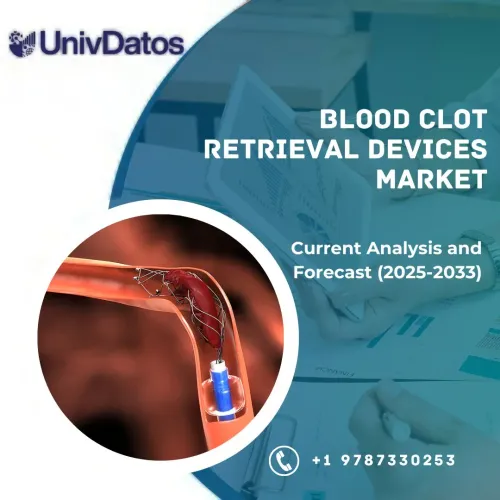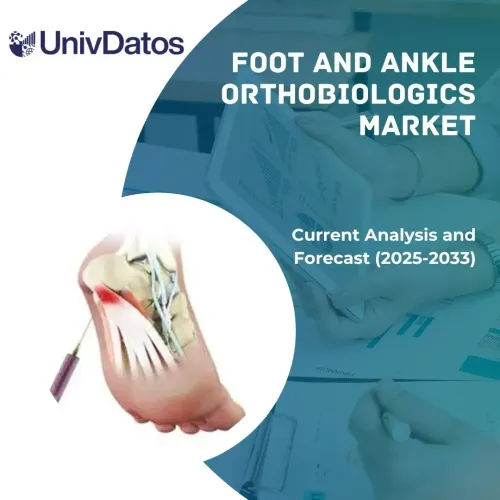- Home
- About Us
- Industry
- Services
- Reading
- Contact Us
Operating Room Integration Market: Current Analysis and Forecast (2025-2033)
Emphasis on Component Type (Software and Service); Device Type (Audio Video Management System, Display System, and Documentation System); Application (General Surgery, Orthopedic Surgery, Neurosurgery, Others); End-Users (Hospitals, Ambulatory Surgical Centers); Region/Country
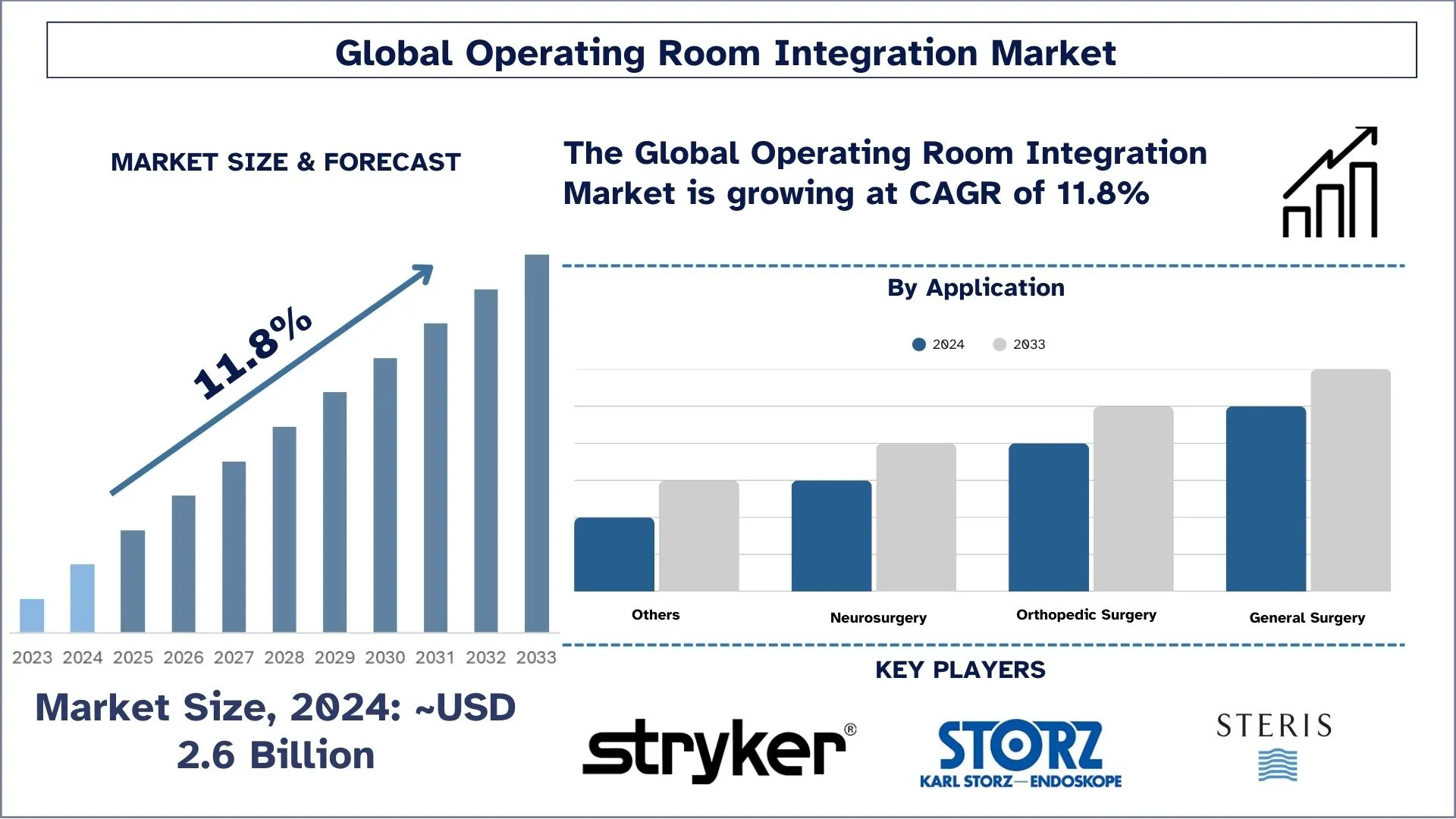
Operating Room Integration Market Size & Forecast
The Operating Room Integration Market was valued at approximately USD 2.6 billion in 2024 and is expected to grow at a substantial CAGR of around 11.8% during the forecast period (2025-2033), owing to the growing demand for efficient and error-free surgical workflows.
Operating Room Integration Market Analysis
The integrated operating room is designed to reduce the complexity of the most complex environments in hospitals, private clinics, or medical institutions. The latest integrated operating room is equipped with a variety of surgical equipment, as well as equipment management systems, medical printers, injectors, operating microscopes, surgical lights, cameras, large screens, and air management equipment. The OR integration system not only integrates devices, but also functionally connects OR environments such as patient information systems, audio, video, OR lights, OR tables, and building automation. When all these technologies are integrated, the various devices will be controlled by a single operator who can be a doctor or nurse.
Operating Room Integration Market Trends
This section discusses the key market trends influencing the various segments of the Operating Room Integration market as identified by our research experts.
The increasing adoption of artificial intelligence (AI) and robotics
Operational expansion in running rooms shows a significant increase toward incorporating artificial intelligence and robotic systems to improve surgical precision alongside operational effectiveness. The ORI market benefits from AI algorithms that support surgical decisions and preoperative planning, as well as intraoperative guidance and robotic systems that execute minimally invasive procedures with enhanced control. AI with robotics systems works together in surgery to transform the workflow, thereby improving patient success while optimizing OR efficiency.
Operating Room Integration Market Industry Segmentation
This section provides an analysis of the key trends in each segment of the global Operating Room Integration market report, along with forecasts at the global, regional, and country levels for 2025-2033.
The General Surgery Segment is Expected to Witness a Higher CAGR than the Operating Room Integration Market.
Based on application, the market is segmented into general surgery, orthopedic surgery, neurosurgery, and others. Amongst applications, the general surgery category accounted for a significant share of the market. General surgery includes surgery on various organs and conditions such as the digestive tract (esophagus and related organs), abdomen and its contents, breasts, skin and soft tissues, and the endocrine system. Thus, the increase in cases of breast cancer, endocrine disorders, liver cancer, etc., contributes to the large number of general surgical procedures, which in turn is fueling the market growth.
The Hospital Segment Holds the Largest Share of the Market.
Based on end-users, the market is bifurcated into hospitals and ambulatory surgical centers. Amongst end users, the hospital category accounted for a significant share of the market. Due to the large number of patients exposed to chronic disease, IORs need to reduce the burden and complexity for physicians and increase the number of hospitals established in developing countries to effectively manage surgical workflows. In addition, continuous innovation in medical devices has contributed to the increased adoption of IORs in the upcoming years.
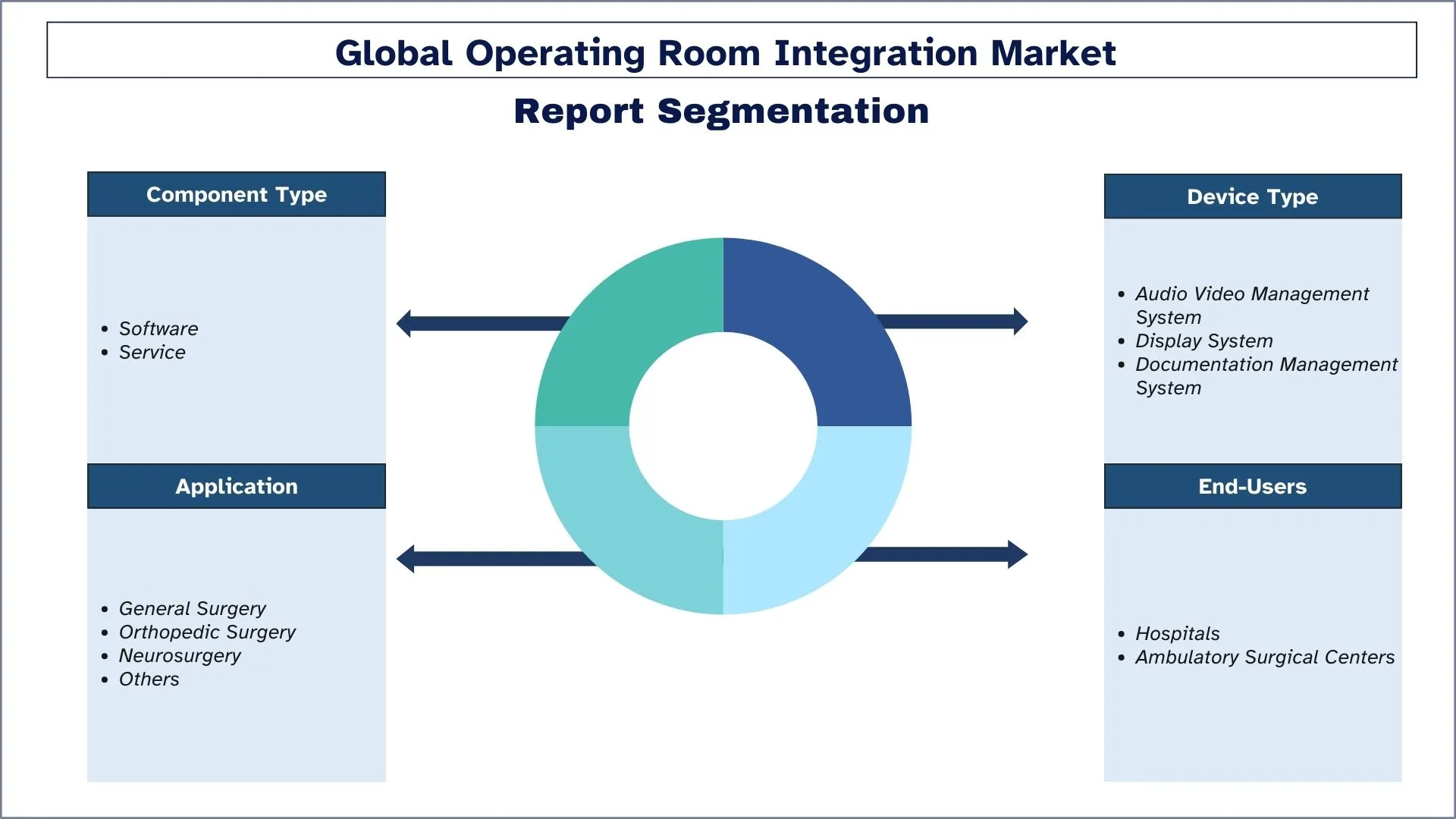
North America has a significant share of the market in 2024.
North American countries dominate the operating room integration (ORI) market because they have advanced healthcare facilities, coupled with numerous surgical procedures, along with quick acceptance of procedures that use minimally invasive surgical techniques. Integrated OR systems have gained widespread adoption because the region focused on bettering surgical outcomes while shortening procedure times through process optimization. ORI solutions experience market growth because of important industry players and strong R&D activities, and fundamental hospital modernization investments. Rising numbers of older people, along with increased incidence of chronic diseases, create sustained demand for technology-based, efficient surgical facilities throughout Asia Pacific.
U.S. Dominates the North American Operating Room Integration Market
The operating room integration market in the U.S. demonstrates robust growth because healthcare facilities adopt superior surgical technologies at an increased pace while managing a higher number of chronic patient cases. Surgical solutions that integrate have gained substantial demand because a large section of the population now faces chronic conditions. Currently, the U.S. healthcare system focuses on surgical enhancements and cost reduction through integrated OR solutions, which optimize workflow procedures while improving surgical accuracy. The United States market expands because of its well-established healthcare facilities and active research-driven approach.
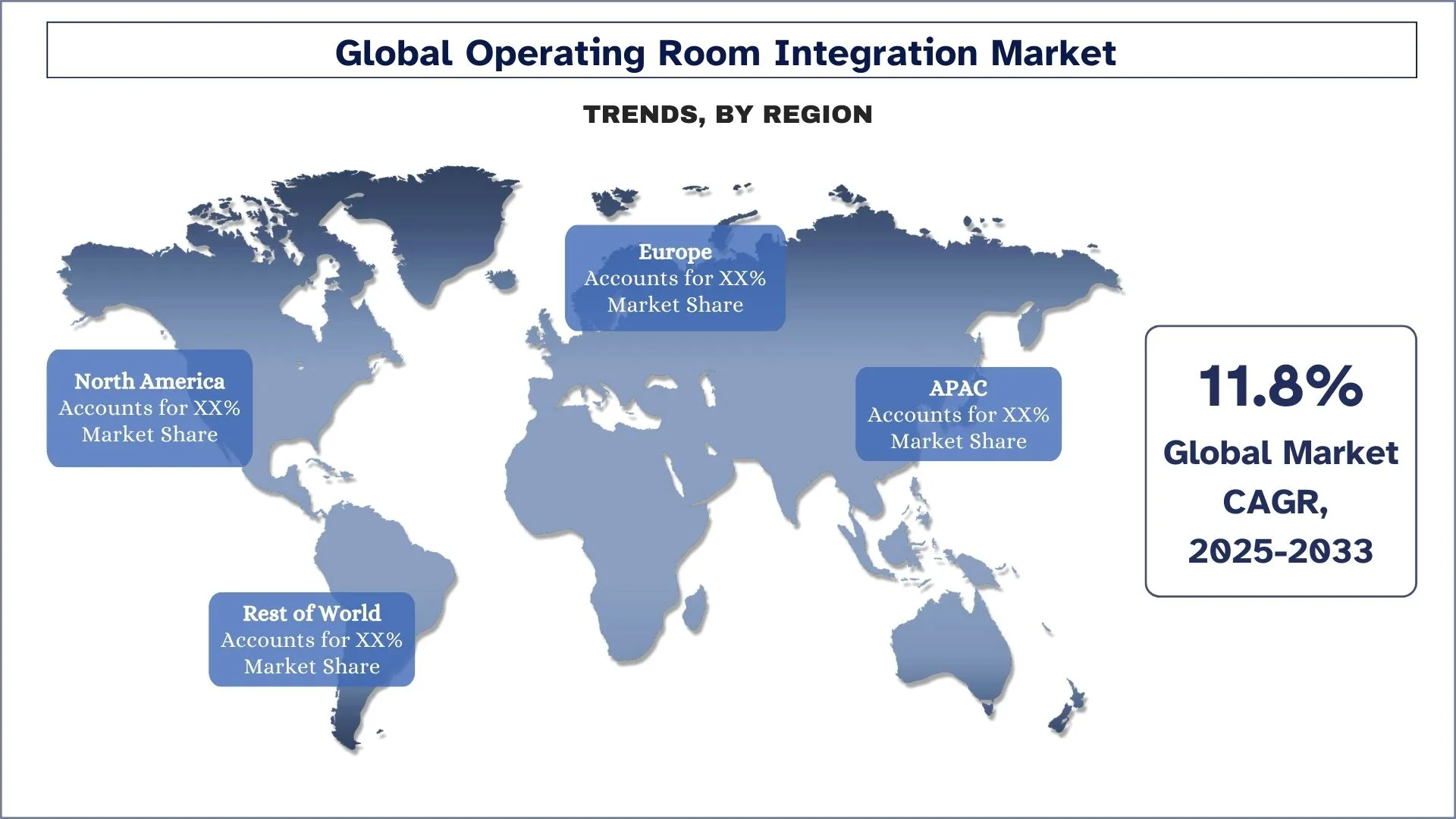
Operating Room Integration Market Industry Competitive Landscape
The Operating Room Integration market is competitive, with several global and international players. The key players are adopting different growth strategies to enhance their market presence, such as partnerships, agreements, collaborations, new product launches, geographical expansions, and mergers and acquisitions.
Top Operating Room Integration Market Companies
Some of the major players operating in the market are Stryker Corporation, KARL STORZ GmbH & Co. KG, STERIS plc, Skytron LLC, Getinge AB, Merivaara Oy, Canon Inc., BrainLab AG, Doricon Medical System, and Olympus Corporation.
Recent Developments in the Operating Room Integration Market
- In February 2023, KARL STORZ collaborated with Asensu Surgical (US). Through this collaboration, the company developed next-generation equipment and aimed to sell Asensus' Intelligent Surgical Unit (ISU) as a standalone device.
- In February 2022, Stryker acquired Vocera Communications (US). This acquisition offers Stryker's Medical division an innovative portfolio that boosts the company's Advanced Digital Healthcare services and advances Stryker's focus on preventing adverse occurrences throughout the continuum of care.
Operating Room Integration Market Report Coverage
Details | |
Base year | 2024 |
Forecast period | 2025-2033 |
Growth momentum | Accelerate at a CAGR of 11.8% |
Market size 2024 | USD 2.6 Billion |
Regional analysis | APAC, Europe, Asia-Pacific, Rest of the World |
Major contributing region | North America is expected to grow at the highest CAGR during the forecasted period. |
Key countries covered | U.S., Canada, Germany, France, UK, Spain, Italy, China, Japan, and India |
Stryker Corporation, KARL STORZ GmbH & Co. KG, STERIS plc, Skytron LLC, Getinge AB, Merivaara Oy, Canon Inc., BrainLab AG, Doricon Medical System, Olympus Corporation. | |
Report Scope | Market Trends, Drivers, and Restraints; Revenue Estimation and Forecast; Segmentation Analysis; Demand and Supply Side Analysis; Competitive Landscape; Company Profiling |
Segments Covered | By Component Type, By Device Type, By Application, By End-Users, By Region/Country |
Reasons to Buy the Operating Room Integration Market Report:
- The study includes market sizing and forecasting analysis validated by authenticated key industry experts.
- The report presents a quick review of overall industry performance at a glance.
- The report covers an in-depth analysis of prominent industry peers with a primary focus on key business financials, product portfolios, expansion strategies, and recent developments.
- Detailed examination of drivers, restraints, key trends, and opportunities prevailing in the industry.
- The study comprehensively covers the market across different segments.
- Deep dive regional-level analysis of the industry.
Customization Options:
The global Operating Room Integration Market can be customized further as per the requirements or any other market segment. Besides this, UnivDatos understands that you may have your own business needs; hence, feel free to contact us to get a report that completely suits your requirements.
Table of Content
Research Methodology for Operating Room Integration Market Analysis (2023-2033)
We analyzed the historical market, estimated the current market, and forecasted the future market of the global Operating Room Integration Market to assess its application in major regions worldwide. We conducted exhaustive secondary research to gather historical market data and estimate the current market size. To validate these insights, we carefully reviewed numerous findings and assumptions. Additionally, we conducted in-depth primary interviews with industry experts across the Operating Room Integration Market value chain. After validating market figures through these interviews, we used top-down and bottom-up approaches to forecast the overall market size. We then employed market breakdown and data triangulation methods to estimate and analyze the market size of industry segments and sub-segments.
Market Engineering
We employed data triangulation techniques to finalize the overall market estimation and derive precise statistical numbers for each segment and sub-segment of the global Operating Room Integration Market. We split the data into several segments and sub-segments by analyzing various parameters and trends, including component type, device type, application, end-users, and regions within the global Operating Room Integration Market.
The main objective of the Global Operating Room Integration Market Study
The study identifies current and future trends in the global Operating Room Integration Market, providing strategic insights for investors. It highlights regional market attractiveness, enabling industry participants to tap into untapped markets and gain a first-mover advantage. Other quantitative goals of the studies include:
- Market Size Analysis: Assess the current and forecast market size of the global Operating Room Integration Market and its segments in terms of value (USD).
- Operating Room Integration Market Segmentation: The study segments the market by component type, device type, application, end-users, and region.
- Regulatory Framework & Value Chain Analysis: Examine the regulatory framework, value chain, customer behavior, and competitive landscape of the Operating Room Integration Market industry.
- Regional Analysis: Conduct a detailed regional analysis for key areas such as Asia Pacific, Europe, North America, and the Rest of the World.
- Company Profiles & Growth Strategies: Company profiles of the Operating Room Integration Market and the growth strategies adopted by the market leaders to sustain the fast-growing market.
Frequently Asked Questions FAQs
Q1: What is the Operating Room Integration market's current size and growth potential?
As of 2024, the global Operating Room Integration market is valued at approximately USD 2.6 billion and is projected to grow at a CAGR of 11.8% through 2033.
Q2: What are the driving factors for the growth of the Operating Room Integration market?
Healthcare providers are under increasing pressure to improve surgical outcomes, reduce procedural time, and enhance patient safety. Integrated operating rooms streamline access to critical data, imaging, and device control in real-time, driving demand across developed and emerging markets.
Q3: Which market has the largest share of the Operating Room Integration market by component type?
The Software segment dominates the global Operating Room Integration market by the component type segment.
Q4: What are the major trends in the Operating Room Integration market?
The market is witnessing a shift toward AI-enhanced OR systems, enabling predictive analytics, automated documentation, and real-time surgical guidance. Integration with hospital EMRs and cloud-based platforms is also becoming standard, supporting smarter, connected OR ecosystems.
Q5: Which region will dominate the Operating Room Integration market?
The North America region currently dominates the global Operating Room Integration Market.
Q6: What are the biggest challenges in the Operating Room Integration market?
Despite long-term efficiency benefits, the upfront cost of OR integration, combined with technical complexity, staff training requirements, and the need to retrofit legacy systems, poses a barrier to widespread adoption, especially in cost-sensitive or resource-limited settings.
Q7: Who are the Top players in the global Operating Room Integration market?
The leading companies driving innovation in the Operating Room Integration market include:
• Stryker Corporation
• KARL STORZ GmbH & Co. KG
• STERIS plc
• Skytron LLC
• Getinge AB
• Merivaara Oy
• Canon Inc.
• BrainLab AG
• Doricon Medical System
• Olympus Corporation
Q8: What role does interoperability play in the success of operating room integration solutions?
Interoperability is critical in ORI as it ensures seamless communication between surgical devices, imaging systems, hospital information systems (HIS), and electronic medical records (EMRs). Integrated systems that support open architecture and vendor-agnostic platforms reduce workflow fragmentation, improve surgical efficiency, and enable better data-driven decision-making. Interoperability also enhances scalability for hospitals upgrading or expanding their systems.
Q9: How can medical device companies or tech firms strategically enter or expand in the OR Integration space?
Companies looking to enter or scale in the ORI market should focus on interoperable solutions, compliance with healthcare regulations (e.g., HIPAA, FDA), and forming strategic partnerships with hospitals, surgical OEMs, or health tech integrators. Emphasizing cybersecurity, scalability, and seamless integration with existing hospital IT systems (like EMRs and PACS) will also be critical. Targeting emerging markets and offering modular or cloud-based ORI solutions can further unlock growth potential.
Related Reports
Customers who bought this item also bought





